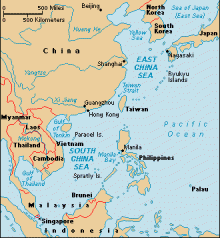
Max Boot said in his New York Times best-selling book, War Made New: “My view is that technology sets the parameters of the possible; it creates the potential for a military revolution.”
But Max Boot isn’t the only one who shares this point of view. The U.S. Intelligence Community has also come to this conclusion. Here is part of what the IC says:
The United States no longer has a monopoly on innovation or innovative technologies. The U.S. Intelligence Community’s capstone publication Global Trends 2030, places a huge emphasis on technology in general and on what it considers potential (and likely) “technological game changers” in the foreseeable future, at least out to 2030. These potential technological game changers are of enormous significance to investment and other business decisions.
Global Trends 2030 notes that technology will figure prominently in what kind of future world we live in. It asks the question, will technological breakthroughs be developed in time to boost economic productivity and solve the problems caused by the strain on natural resources and climate change as well as chronic disease, aging populations, and rapid urbanization
Read the entire article here on the Defense Media Network website and consider what role technology will play in ensuring our security and prosperity.

There are few issues where the U.S. intelligence community, academia, industry, the U.S. military, and think tanks all agree.
The singular issue that brings all of them together is this: The one existential threat to the United States is ballistic missiles armed with weapons of mass destruction.
Today, a number of unstable nations possess these weapons. The U.S. Missile Defense Agency has a number of assets for defense against ballistic missiles with weapons of mass destruction.
And by any estimate, the most important weapon for defense against ballistic missiles with WMD is built around the U.S. Navy Aegis weapons system with a BMD package.
The U.S. Navy’s contribution to U.S. BMD is based on the Aegis weapon system and has been on patrol in guided-missile cruisers and destroyers since 2004. Aegis BMD has grown in importance based on its proven performance as well as its long-term potential.
Read more about this issue – including our article in U.S. Naval Institute Proceedings.

Few issues related to national security fire up such passion as the use of unmanned or autonomous systems for military use. Over the past decade, these technological wonders have been used on the battlefield as well as in targeted killings of terrorists. By-and-large, the public is torn on this issue, suffice it to say, there has been vastly more heat than light regarding their use.
The expanding use of armed unmanned systems (UxS) is not only changing the face of modern warfare, but also altering the process of decision-making in combat operations. Indeed, it has been argued that the rise in drone warfare is changing the way we conceive of and define “warfare” itself. These systems have been used extensively in the conflicts in Iraq and Afghanistan, and will continue to be equally relevant – if not more so – as the United States’ strategic focus shifts toward the Asia-Pacific region and the high-end warfare this strategy requires. The exploding use of UxS is already creating strategic, operational, and tactical possibilities that did not exist a decade ago.
With the prospect of future flat or declining military budgets, the rapidly rising costs of military manpower, and the increased DoD emphasis on total ownership costs, the mandate to move beyond the “many operators, one-joystick, one-vehicle” paradigm that has existed during the past decades for most UxS is clear and compelling. The DoD and the services are united in their efforts to increase the autonomy of UxS as a primary means of reducing manning and achieving acceptable total ownership costs. But this drive for autonomy begs the question as to what this imperative to increase autonomy comports and what, if any, downside occurs if we push UxS autonomy too far. Is there an unacceptable “dark side” to too much autonomy?
Read the entire article here on the Defense Media Network website and consider what the dark side of autonomy could mean:

In a recent post we talked about Black Swans that could completely change the world as we know it. These certainly bear watching. But there is another factor that could be the decisive factor in the international society evolving one way or the other. That factor sounds deceptively simple: It is the United States chooses to play in the world.
Much has been made in the last decade regarding “America’s decline.” And given the current Washington gridlock, to say nothing of the shrill predictions of some pundits, one would think the United States is about to become a third-world power. It has become a debate that, while poorly-informed, makes up for it in passion.
Beyond the shrill voices and often-unbridled passion, well-nuanced and informed studies have poured out of think tanks and elsewhere over the past several years offering prescriptions for ways the United States can and should remain the dominant world power. Other studies have predicted decline, some others have predicted ascendency, and others have left it to the reader. What most of these studies do agree on is that the world will no longer – and likely will never again be – a unipolar one the way it was immediately after the end of World War II or again decades later after the Soviet Union imploded. In both cases, the United States was the unipolar power.
Rather than “predict” the strength, or weakness, of the United States in the ensuing decades, Global Trends 2030 suggests that it is most important to focus on what role the United States chooses to play in the world years hence. And while other factors will certainly affect how this role is shaped, Global Trends 2030 makes the point that how the United States interacts with the rest of the world will be largely determined by choices this nation makes.
Read more here on the Defense Media Network website:

By any measure, Navy SEALs have had an extraordinarily prominent role in our national security over the past decade, from their sacrifices in the field that resulted in several SEALs, Michael Murphy and Michael Monsoor receiving the Medal of Honor, to the rescue of Captain Richard Phillips held by Somali pirates, to the takedown of terrorist Osama bin Laden.
And much of this has been captured in the media, from prominent movies like Act of Valor and Captain Phillips, to a flurry of books like Chris Kyle’s American Sniper, to SEALs running for office. But now many Navy SEALs are questioning whether their fellow warriors should be “cashing in on the brand.”
In recent months, the Naval Special Warfare Command in Coronado, Calif., which oversees the elite force, has told its men to lower their profile and tried to rein in public appearances by active-duty members. The Pentagon imposed a rule last September restricting the appearance of service members in video games, movies and television shows. Current and former members have widely circulated a pointed critique — titled “Navy SEALs Gone Wild: Publicity, Fame, and the Loss of the Quiet Professional” — that laments the commercialization and warns that it is doing harm.
“The raising of Navy SEALs to celebrity status through media exploitation and publicity stunts has corrupted the culture of the SEAL community by incentivizing narcissistic and profit-oriented behavior,” Lt. Forrest S. Crowell, a SEAL, wrote in the critique, his master’s thesis for the Naval Postgraduate School in Monterey, Calif. Partisan politicking and public disclosure of tactics, he added, “erodes military effectiveness, damages national security, and undermines healthy civil-military relations.”
Read more about this issue – one that played out on the front page of the New York Times:

The Washington Post recently ran an interesting interview with the author of a new global/future trends book that is probably worth your attention if you follow long-term geo-political-economic-environmental trends (especially the six maps of US, North America, and the World highlighted from the book).
The author of the new book Connectography: Mapping the Future of Global Civilization, argues that the arc of global history is undeniably bending toward integration. Instead of the boundaries that separate sovereign nations, the lines that we should put on our maps are the high-speed railways, broadband cables and shipping routes that connect us, he says. And instead of focusing on nation-states, he suggests we should focus on the dozens of mega-cities that house most of the world’s people and economic growth.
This is interesting food for thought in any case and comports with our earlier postings on the Director of National Intelligence’s Global Trends 2030.
Read the entire article here – and enjoy these thought-provoking maps:
https://www.washingtonpost.com/news/wonk/wp/2016/04/29/six-maps-that-will-make-you-rethink-the-world/?hpid=hp_rhp-top-table-main_6-maps-950a%3Ahomepage%2Fstory

In a recent post we talked about Game Changers rocking our world. While megatrends and tectonic shifts represent those trends that will likely occur under any future scenario, game changers are those potential shifts that could be even more disruptive to how we currently see the future.
But beyond these game-changers are potential events we call Black Swans. Briefly, at its very basic elements, the black swan theory or theory of black swan events is a metaphor that describes an event that is a surprise to the observer, has a major effect, and after the fact is often inappropriately rationalized with the benefit of hindsight.
The phrase “black swan” derives from a Latin expression. Its oldest known occurrence is the poet Juvenal’s characterization of something being “a rare bird in the lands, very much like a black swan.” When Juvenal coined the phrase, the black swan was presumed not to exist. Therefore, black swan gets to the heart of the fragility of any system of thought.
A set of conclusions is potentially undone once any of its fundamental postulates is disproved. In this case, the observation of a single black swan would be the undoing of the phrase’s underlying logic, as well as any reasoning that followed from that underlying logic. For those who have read Andrew Krepinevich’s book, 7 Deadly Scenarios these black swan events are equally terrifying – or hopeful – and no-less believable.
Read more here on the Defense Media Network website:
http://www.defensemedianetwork.com/stories/global-trends-2030-black-swans/

Few writers have been so universally recognized as being prescient about the future than Tom Clancy. Even years after his untimely death in 2013, fans and observers all over the world still marvel at his ability to see more clearly into the future than most of us could ever hope to. He had a knack.
Tom Clancy’s complex, adrenaline-fueled military novels spawned a new genre of thrillers and made him one of the world’s best-known and best-selling authors. When Clancy died in October 2013, one of the most celebrated authors of our generation no longer walked among us.
Many people had – and continue to have – diverse options about Tom Clancy. However, most agree, above all else, he was prescient about the future of geopolitics, intelligence, military operations and emerging technology and weaponry. In his own words:
I hang my hat on getting as many things right as I can. I’ve made up stuff that’s turned out to be real — that’s the spooky part.
Tom Clancy also left a gift for aspiring writers with words that are as important today as when he said them years ago He said none of his success came easily, and he would remind aspiring writers of that when he spoke to them:
I tell them you learn to write the same way you learn to play golf. You do it, and keep doing it until you get it right. A lot of people think something mystical happens to you, that maybe the muse kisses you on the ear. But writing isn’t divinely inspired — it’s hard work.

Earlier this month we posted a national security blog focused on Tectonic Shifts impacting the world in the decades ahead. Like mega-trends these shifts represent long-term trends that we can be reasonably sure will happen if forces already in motion continue on their current paths. These are the fundamental underpinnings regarding how the intelligence community – the IC – looks at the future, based on, to borrow a phrase from former Secretary of Defense Donald Rumsfeld, “known-knowns.”
But what about, again borrowing from Rumsfeld, the “known-unknowns?” GT2030 has identified six potential “game-changers,” events that we cannot say will happen, but that could happen under certain sets of conditions.
Although these megatrends and tectonic shifts are expected to shape the world out to 2030, GT2030 acknowledges that these critical game-changers have the potential to largely determine “what kind of transformed world will be inhabited in 2030.” These game-changers are questions regarding:
- The health of the international economy
- Global governance
- Conflict
- Regional instability
- Technological breakthroughs
- The role of the United States
How important – and potentially impactful – are these potential game-changers? “Global Trends 2030” dedicates 70 pages of this 160-page report to them. This fact, in and of itself, tells us that they bear watching. This link to “Global Trends 2030” will enable you to look at these potential game-changers in detail.
Read more here on the Defense Media Network website:
http://www.defensemedianetwork.com/stories/global-trends-2030-game-changers/

If there is one place on earth where the ambitions of the United States and China collide, it is the South China Sea. This body of water all-but-dominates the news weekly, with China making increasingly aggressive claims to this crucial body of water. Is it any wonder that many think World War III could well start there. We wrote about this in the U.S. Naval Institute Proceedings. Here is part of what we shared:
Whether it is the intelligence community, the military, industry, or just individuals attempting to get some notion of what the future holds, extrapolating current trends to determine likely outcomes in years “downstream” is absolutely essential to stay one step ahead of any current – or future – adversaries. This is the work of military and intelligence analysts and is more essential today than ever before.
Access and use of the global commons, particularly the sea and the air space, is a core element of U.S. military and commercial power. In times of war, control of the commons may be ensured by military means. In peacetime it is sought through international law and diplomacy and through limited military responses when the rules governing use of the commons are breached. In some cases, a peacetime incident may quickly result in a reaffirmation of traditional freedoms of the sea. In others, a more concerted effort, combining diplomacy with demonstration, is needed to return to adherence to international norms. This latter combination appears to be the case regarding China and the South China Sea. As noted recently by Patrick Cronin and Paul Giarra:
Chinese assertiveness over its region is growing as fast as China’s wealth and perceived power trajectory. Beijing’s unwelcome intent appears to give notice that China is opting out of the Global Commons.
Though not a new phenomenon, China’s increasingly assertive activities in the South China Sea are drawing concern that the country is seeking regional hegemony at the expense of its neighbors in Southeast Asia as well as the United States, Japan, and South Korea.
You can read this entire article here:
http://georgegaldorisi.com/wp-content/uploads/Galdorisi-April-11.pdf











